The Impacts of One-Sided Activities on Your Dog’s Health
It may come as a surprise, but consistently engaging your dog in activities that work one side more than the other can significantly affect their muscle development and joint health.
By performing a simple exercise, you can identify muscular imbalance and possible muscle tension that your dog may be experiencing. If not reversed this imbalance can lead to restricted movement, compensation, increased risk of muscular injuries, and uneven, excessive loading on healthy joints. None us of want that!
The statistics tell us that 35% of dogs over the age of 12 months have arthritis and up to 80% of dogs over the age of 8 years old. It is a progressive disease and there is no cure. Uneven loading on healthy joints is thought to be a significant contributing factor.
Weight Distribution: How Dogs Carry Their Weight
An essential aspect of canine physiology that often goes under the radar is how dogs distribute their weight. Typically, a dog carries about 60% of its weight on the front legs and the remaining 40% on the hind legs. This natural distribution plays a pivotal role in how a dog moves, reacts, and even how their muscles and bones develop over time.
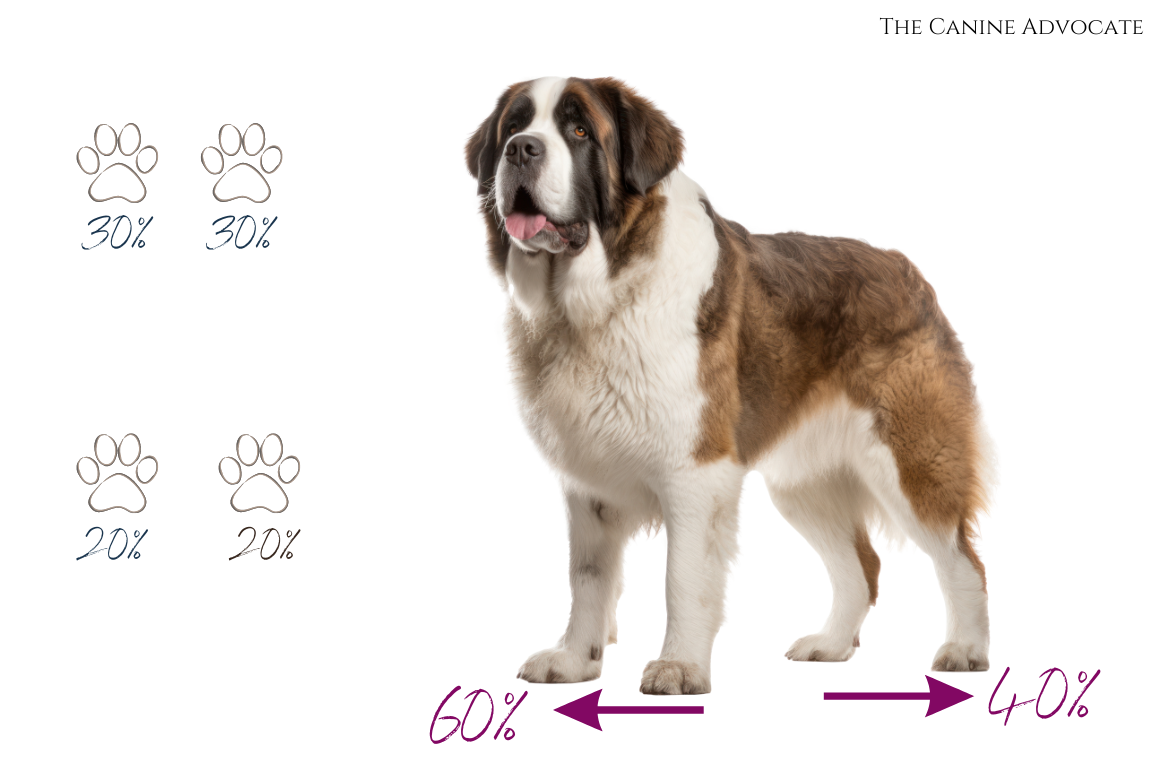
Weight distribution percentages in dogs
The front legs support the majority of the dog’s weight, 60% (30% through each front leg) making the front legs pivotal for absorbing impact, particularly during activities like walking, running, digging or landing from a jump, for example when your dog jumps out of the car.
Conversely, the back legs, although carrying less weight 40%, (20% through each back leg) are crucial for propulsion, acceleration, deceleration, twisting, and turning.
Overworking muscle causes compensation
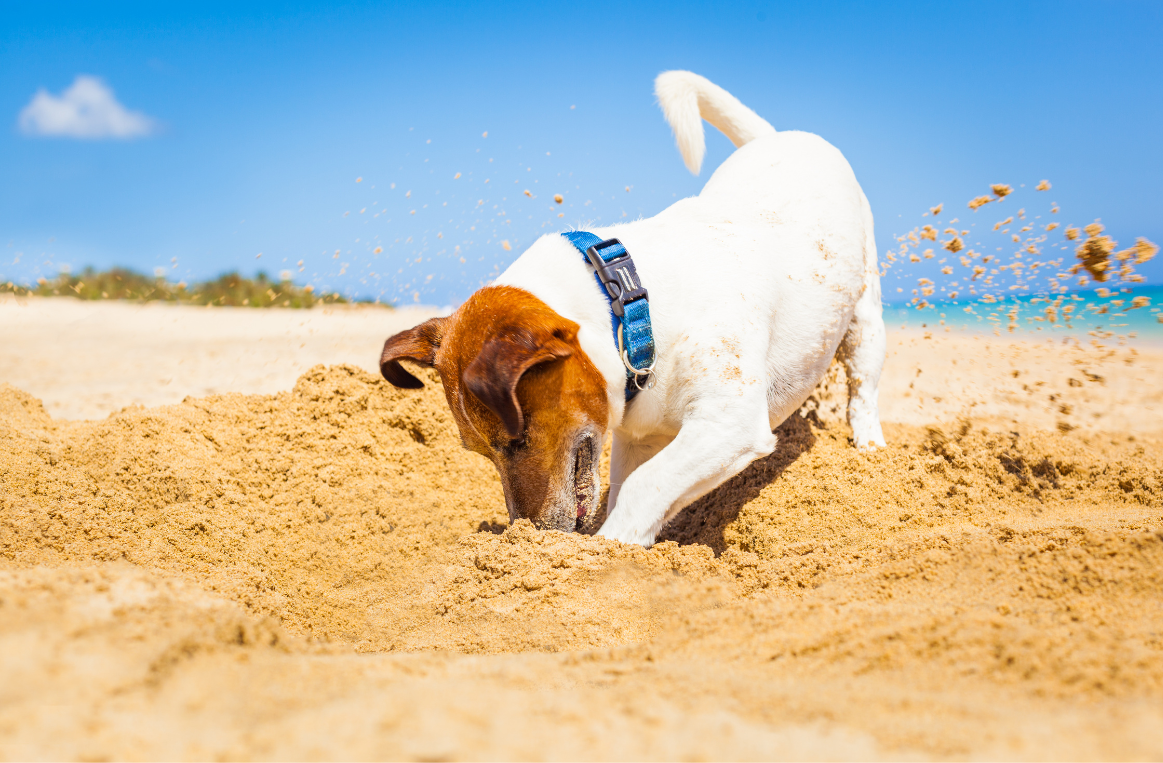
Dog digging to the centre of the earth.
Understanding the nuances of weight distribution is fundamental when considering potential muscle weakness.
When a dog’s back legs are weaker or underperforming, the weight of the dog’s body will shift to the front. This means the muscles at the front have to work much harder. They become overdeveloped, tight, sore and restricted.
The dogs front end weight bearing percentage will increase to more than 60% in total. Weight bearing may even differ from left front leg to right front leg. As a consequence of weight shifting forward the back end will carry less that the expected 40% weight bearing total.
This theory underpins the importance of balanced exercises or activities that engage both the front and hind quarters equally ensuring even muscle development to effectively support the dog’s musculoskeletal frame as they grow older.
In other words if the dogs body is out of balance they will overcompensate, resulting in uneven loading on healthy joints. Remember those arthritis statistics?
The Stance Analyser: A Tool to Measure Weight Distribution Through The Limbs
You can measure weight distribution using a stance analyser (Force Plate Analysis). A dog will stand still on an analyser platform that will electronically measure the weight of each leg. But not everyone has access to one. However, if you do get an opportunity to try one out, please bear this in mind:
- If you don’t have a normal reading for your dog how can you know what is an abnormal reading?
- Does the perfect 30/30 front end and 20/20 back end even exist?
- And if the perfect body does exist, in what % of the dog population is that?
I would guess that there are very few humans with equal weight distribution left vs right and we only have 2 legs to contend with.
What it can do though is determine significant weight shifts.
Test The One-Sided Theory with this Simple Exercise
To observe the effects of one-sidedness firsthand, there is a very simple exercise you can do using just an upright pole and have your dog on a lead.
By slowly walking your dog around the pole 3 times one way and then 3 times the other way with your dog closest to the pole, you may notice one direction is more challenging for them than the other. So for dogs walked consistently on the owner’s left, the right turn will be more difficult.
How can you gauge which way is more difficult?
That’s the easy part. Observe how close your dog can get to the pole without knocking it, and if they can walk slowly in a neat circle around it. You might find your dog needs to be further away from the pole in one direction.
The difficult part is performing the exercise without physically influencing them.
During the exercise, you’ll be astonished at just how much you interfere with your dog’s natural movement. You’ll tug on the lead or put your leg in your dog’s way to make the turn tighter than it would be if your dog had been left to perform the movement naturally. This is a nice easy way to highlight uneven muscle development.
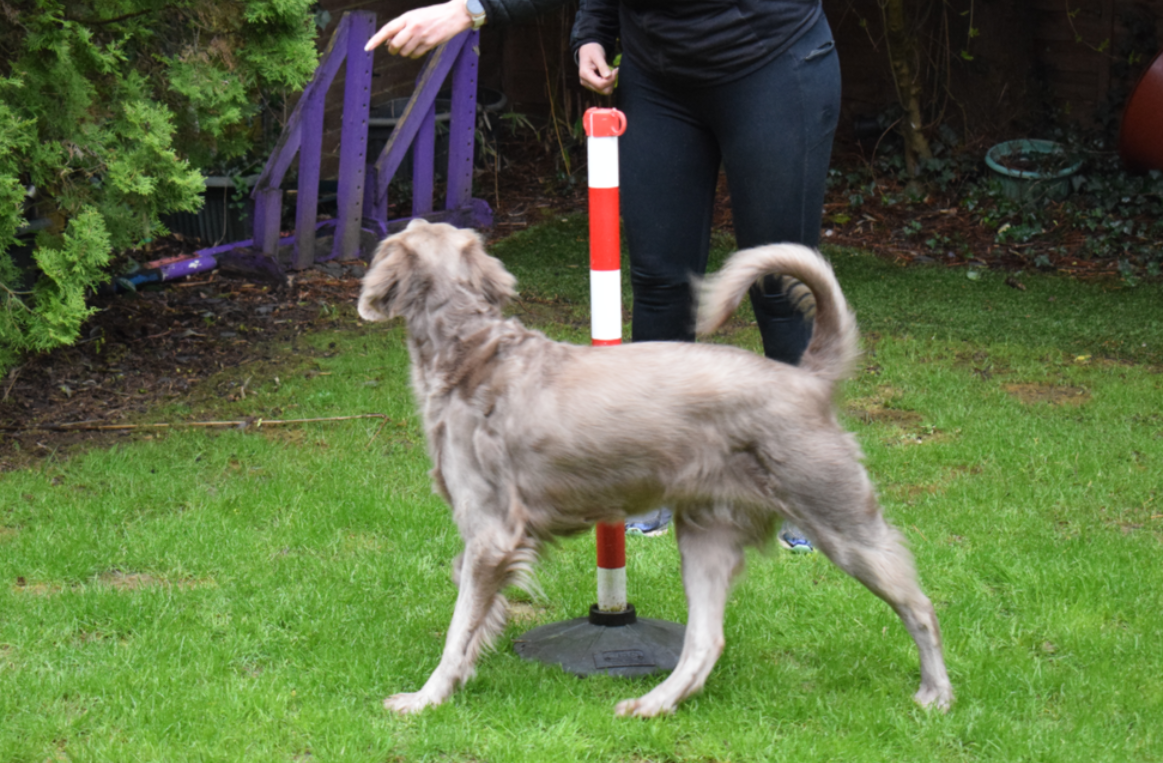
Debbie teaching Reeva around the pole
Common Causes of Uneven Muscle Development
Various factors can contribute to uneven muscle growth in dogs but here are some of the most common:
- Walking your dog just on one side
- Training your dog just on one side
- Conformation (How they are built)
- Inappropriate exercise
- Over exercise
- Inappropriate use of equipment (eg untrained use of balance balls, wobble cushions)
- Sport-specific training only
- A restrictive or poorly fitted harness, headcollars
- Constant pulling on the lead
- Injury
- Poor diet
- Orthopaedic conditions like arthritis, cruciate disease, hip / elbow dysplasia
- Poor posture
- But one of the biggest contributors I’ve found is when a dog has a weak muscular core
Recognising these factors is crucial in taking the correct steps needed to prevent imbalance and weakness. With core conditioning you can turn this around at any age to optimise your dog’s musculoskeletal health and well-being.
Strategies to Prevent Asymmetrical Muscle Growth in Dogs
Encouraging symmetrical activities is key to promoting even muscle growth in dogs. Being aware of your dog’s physical and emotional state during activities can help prevent fatigue, discomfort, and injury. Understanding that dogs have a complex muscular system is essential in appreciating the importance of balanced muscle and avoiding overcompensation at all costs.
The easiest way to counter movement which causes imbalance on one side is to perform the same movement on the opposite side. For example, if you always walk your dog on the left – walk them equally on the right.
From Understanding Weight Distribution to Getting Wise About Core Conditioning
Recognising how a dog carries its weight is just the beginning. While not every pet owner has access to advanced tools like a stance analyser to monitor their dog’s weight distribution continuously, there’s a practical and accessible approach to ensuring balanced muscle development: Core Conditioning.
Bridging the Gap with Core Conditioning
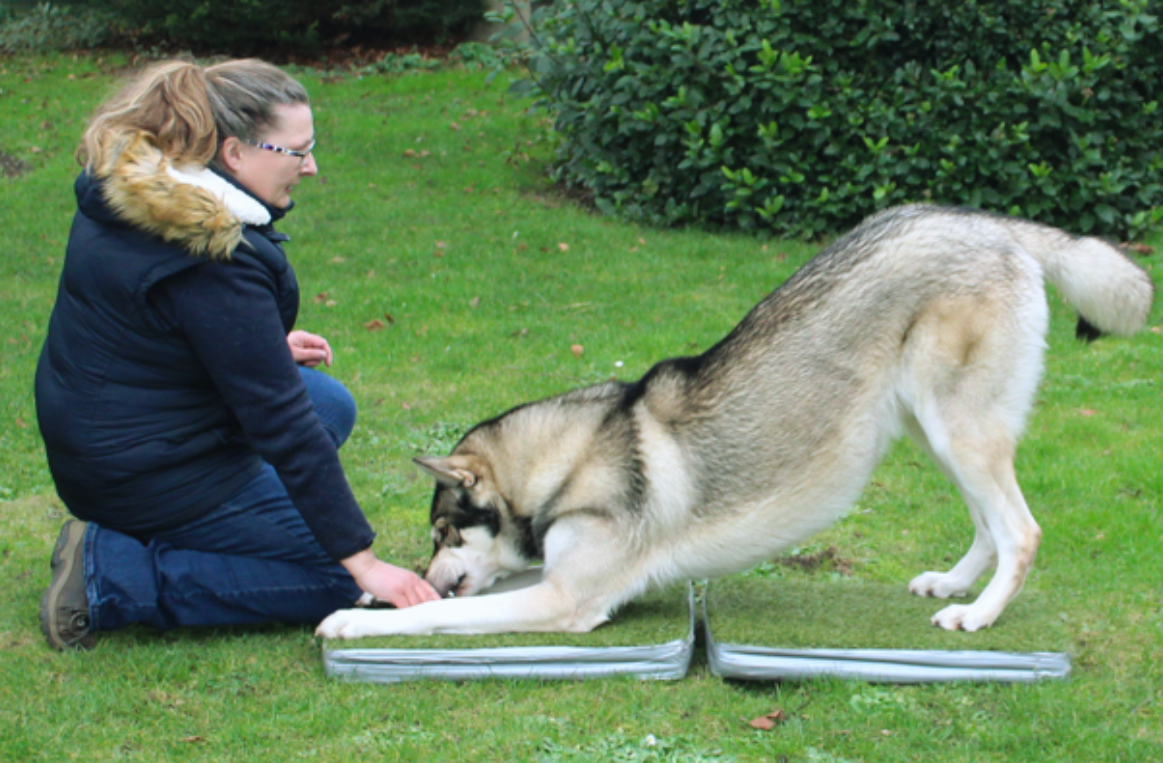
Angela teaching her puppy Hunter a play bow
Core conditioning closes the gap between canine physical therapies and sport-specific training. These exercises are meticulously designed for each dog to be slow, controlled, and low-impact, aiming to target and address muscular weaknesses across the body.
This tailored approach makes core conditioning the ideal program for dogs of all ages, from young pups at 12 weeks to senior dogs at 14 years.
Angela Day, multi-award winning therapist and founder of Born to Run says, “As a CCA Core Conditioning Instructor, and Small Animal Rehab Specialist I rely on meticulous, skilled, visual assessments of gait, posture, and various ground and dynamic tests, muscle measures, and photographic evidence to gauge true muscle imbalance. I then put together a unique plan designed specifically for the dog in front of me. Because every dog is different right? After all these years I am still amazed at the incredible, positive changes that Core Conditioning brings to a dog’s demeanor, mind and body.”
Conclusion
Ensuring your dog engages in balanced physical activities is paramount for optimal muscle development and joint health.
By acknowledging the risks of uneven muscle growth and by integrating core conditioning into their daily routine, you not only ensure balanced muscle development in your dog but also contribute to their overall physical and emotional well-being.
This proactive approach will bring your dog closer to their healthiest, happiest life!
Work with Angela
Described as having a “peace of mind” approach to your dog’s fitness Angela offers a personalised cca core conditioning program, where every exercise is tailored to your dog’s unique needs, ensuring you never have to worry about overdoing it again and can enjoy active, injury-free adventures together.
Your 7 week bespoke training program awaits!
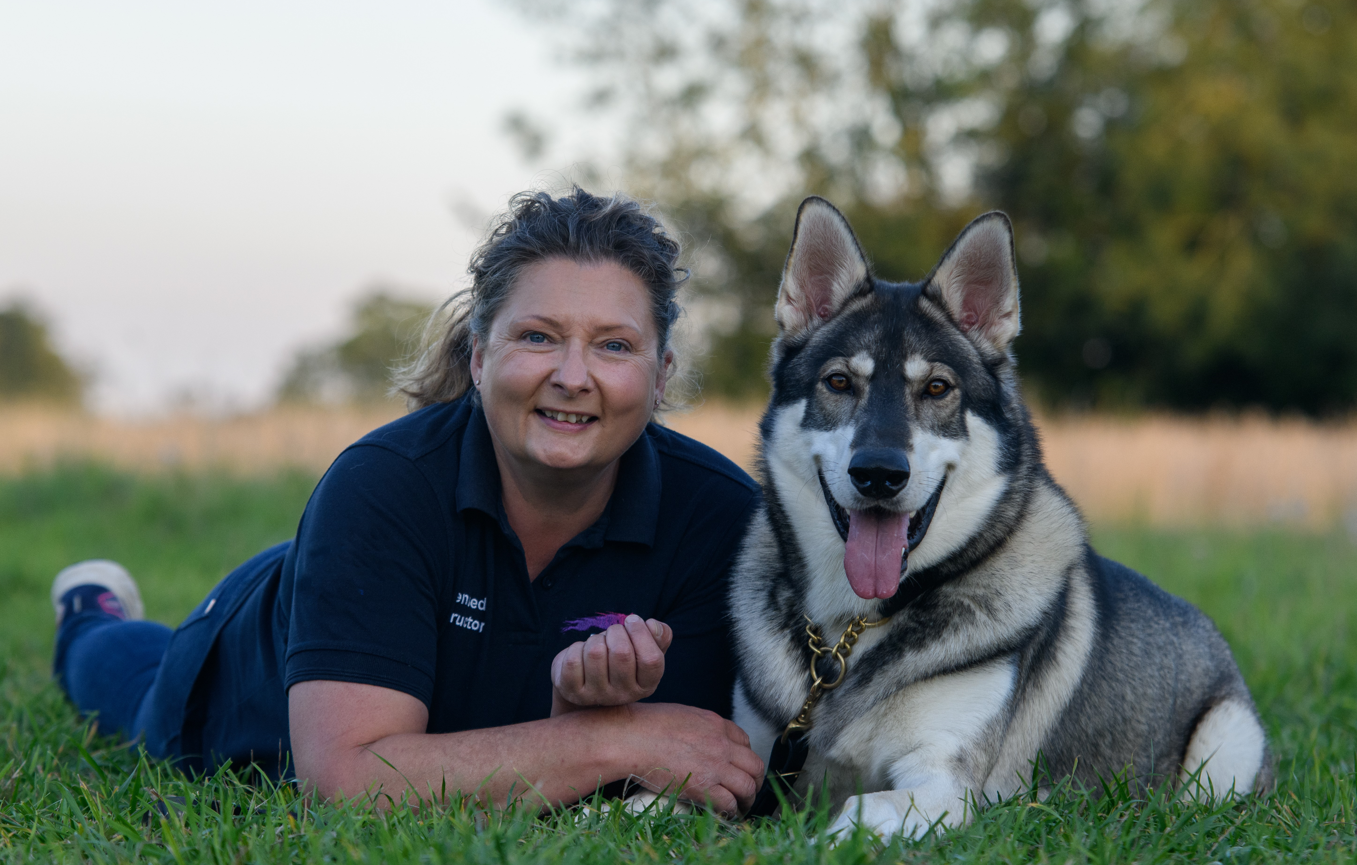


I would like to learn more
Hi Chris Awesome! Feel free to visit my website for more information, or boom a call from our contact page links are in the blog All the best!